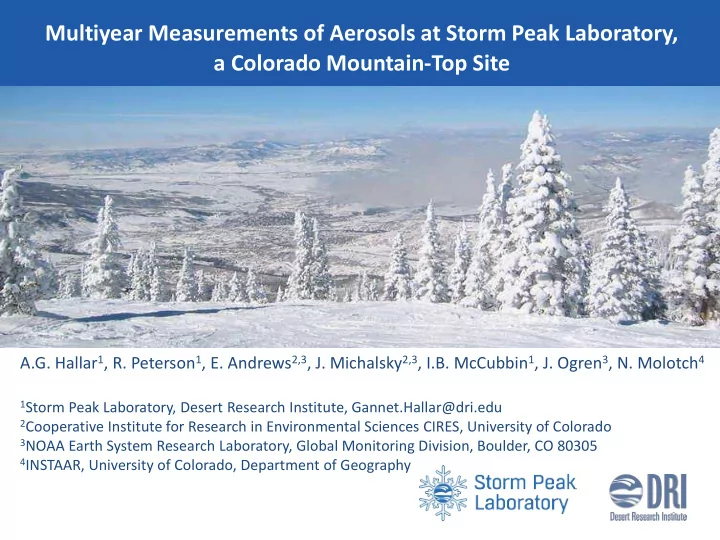

Storm Peak Laboratory | Desert Research Institute Multiyear Measurements of Aerosols at Storm Peak Laboratory, a Colorado Mountain-Top Site A.G. Hallar 1 , R. Peterson 1 , E. Andrews 2,3 , J. Michalsky 2,3 , I.B. McCubbin 1 , J. Ogren 3 , N. Molotch 4 1 Storm Peak Laboratory, Desert Research Institute, Gannet.Hallar@dri.edu 2 Cooperative Institute for Research in Environmental Sciences CIRES, University of Colorado 3 NOAA Earth System Research Laboratory, Global Monitoring Division, Boulder, CO 80305 4 INSTAAR, University of Colorado, Department of Geography
Storm Peak Laboratory | Desert Research Institute Aerosol, Cloud, and Trace Gases Research and Education Facility Located on Steamboat Springs Ski Resort Elevation: 3220 m (10,530 ft) Pressure: ~ 690 mb In cloud ~25% of time in winter Mixed Phase Clouds 9 Person Bunkhouse Full Kitchen, Running Water Facility and Guest Instruments Wet Chemistry Lab
Storm Peak Laboratory | Desert Research Institute Climate Emission Drivers Emitted Compound Radiative Forcing by Emissions and Drivers Level of Confidence CO 2 Very High CH 4 High Aerosols and precursors High Mineral Dust Sulphate Nitrate Organic Carbon Black Carbon Cloud adjustments due to aerosols Low High 2011 Man’s impact relative High 1980 to the year 1750 1950 Medium -1 0 1 2 3 Radiative Forcing relative to 1750 (W m 2 )
Storm Peak Laboratory | Desert Research Institute Framework Climate Change Aerosols Wildfires Dust Events Water (Drought)
Storm Peak Laboratory | Desert Research Institute Increasing Wildfires in Western U.S. Number of fires increasing Fire size is increasing Source: Dennison et al., GRL, 2014 . Wildfire activity strongly associated with spring snowmelt timing, which is sensitive to changes in temperature. Source: Westerling et al., Science 2006
Storm Peak Laboratory | Desert Research Institute Increasing Dust in Western U.S. Neff et al., 2008; Nature Geoscience “dust load levels increased by 500% above the late Holocene average following the increased western settlement of the U.S. during the 19 th century. …caused by the expansion of livestock grazing in the early 20 th century.” Painter et al., 2007, Nature Phoenix, AZ dust storm in July 2012. Photograph by Ross D. Franklin, AP Frequency of dust deposition and radiative forcing doubled when the Colorado Plateau experienced intense drought. Source: Center for Snow & Avalanche Studies
Storm Peak Laboratory | Desert Research Institute Instrument at Storm Peak Laboratory Visible Multifilter Rotating Shadowband Radiometer (vis-MFRSR) USDA monitoring network Data from 1999-2013 Calibrated using Langley plots (Michalsky et al. 2001) Cloud screening (Michalsky et al., 2013) Daily AOD calculated from measurements that passed cloud screening TSI integrating nephelometer (Model 3563, St. Paul, Minnesota) Data from 2011-2014 Calibrated with particle-free air and CO 2 Zero checks on filtered air were performed hourly Ångström Exponent α Inst = ln( 2 / 1 )/ln( 1/ 2) sp, sp, MFRSR 1=500 nm, 2=870 nm; Nephelometer 1=450 nm, 2=700 nm.
Storm Peak Laboratory | Desert Research Institute Seasonality of AOD at Storm Peak Laboratory 1999-2013
Storm Peak Laboratory | Desert Research Institute Fires observed at Storm Peak Laboratory Identified by MODIS - Val Martin et al., ACP, 2013
Storm Peak Laboratory | Desert Research Institute Observation of Fires at Storm Peak Laboratory 1999-2013 Decreasing Particle Size
Storm Peak Laboratory | Desert Research Institute Observation of Fires at Storm Peak Laboratory 2011-2013 Angstrom Exponent (450nm/700nm) Scattering (550 nm)
Storm Peak Laboratory | Desert Research Institute Dust observed at Storm Peak Laboratory * Average of 3 consecutive dust events at CSAS
Storm Peak Laboratory | Desert Research Institute Observation of Dust at Storm Peak Laboratory 1999-2013
Storm Peak Laboratory | Desert Research Institute Observation of Dust at Storm Peak Laboratory 2011-2013
Storm Peak Laboratory | Desert Research Institute Summary Dataset highlights wide scale implications of a warmer drier climate on aerosol loading in the Western U.S. Spring AOD is dominated by dust aerosols Summer AOD dominated by aerosols associated with biomass-burning Supported with nephelometer measurements at surface Median contribution to spring and summer AOD by dust and biomass-burning is comparable. Summer AOD correlates with large scale aridity
Storm Peak Laboratory | Desert Research Institute Acknowledgements Storm Peak Laboratory/Desert Research Institute: Dr. Melanie Wetzel, Dr. Doug Lowenthal, P. Tyson Atkins, Dr. Randy Borys References: Livneh et al., 2013: A Long-Term Hydrologically Based Dataset of Land Surface Fluxes and States for the Conterminous United States: Update and Extensions. J. Climate , 26 , 9384– 9392. Michalsky, J. J., et al.: Multiyear measurements of aerosol optical depth in the Atmospheric Radiation Measurement and Quantitative Links programs. Journal of Geophysical Research: Atmospheres 106.D11 (2001): 12099-12107. Michalsky, J., and B. LeBaron (2013), Fifteen-year aerosol optical depth climatology for Salt Lake City, J. Geophys. Res. Atmos., 118, 3271–3277, doi: 10.1002/jgrd.50329 Val Martin, M., et al. "A decadal satellite analysis of the origins and impacts of smoke in Colorado." Atmospheric Chemistry and Physics 13.15 (2013): 7429-7439
Recommend
More recommend